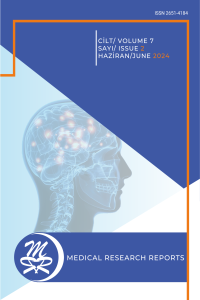Bilişsel Davranışçı Terapi 15 Yaşındaki Bir Ergende Disosiatif ve Kendine Zarar Verme Davranışlarıyla Birlikte Görülen Sosyal Anksiyete Bozukluğunda Etkili Olabilir mi?
Abstract
Sosyal anksiyete bozukluğu ergenler için oldukça zorlayıcı olabilir ve bu bozukluk sosyal etkileşimlerden kaçınma, yoğun kaygı ve zaman zaman disosiasyon semptomlarına yol açabilen bir klinik tabloya sahiptir. Bu vaka çalışmasında sosyal anksiyete bozukluğu, disosiasyon belirtileri ve kendine zarar verme davranışları olan 15 yaşındaki bir kız hastanın tedavi sürecini inceledik. Başlangıçta anksiyete, sosyal durumlardan kaçınma ve disosiasyon belirtileri gösteren hastanın Bilişsel Davranışçı Terapi (BDT) ile önemli bir ilerleme kaydettiği görüldü. Bu vakanın dikkate değer bir yönü, hastanın hayali arkadaşlarla etkileşim olarak ortaya çıkan disosiasyon deneyimiydi. Bu deneyim, sosyal anksiyete bozukluğu bağlamında disosiatif semptomların daha sık düşünülmesi ve araştırılması gerekliliğini vurgularken semptomların temel kökenlerinin ele alınmasının önemine de dikkat çekmektedir. Terapide ana odak noktamız başlangıçta sosyal kaygıyı azaltmak olsa da hastanın disosiatif semptomlarının ve kendine zarar verme davranışlarının BDT ile önemli ölçüde düzelmiş olması, BDT'nin sosyal anksiyete bozukluğu, disosiasyon ve kendine zarar vermeyi yönetmek için etkili bir tedavi seçeneği olarak önemini vurgulamaktadır.
References
- Rapee RM, Creswell C, Kendall PC, Pine DS, Waters AM. Anxiety disorders in children and adolescents: A summary and overview of the literature. Behav Res Ther. 2023;168:104376.
- Hofmann SG, Hay AC. Rethinking avoidance: Toward a balanced approach to avoidance in treating anxiety disorders. J Anxiety Disord. 2018;55:14-21.
- Černis E, Evans R, Ehlers A, Freeman D. Dissociation in relation to other mental health conditions: An exploration using network analysis. J Psychiatr Res. 2021;136:460-467.
- Lofthouse MK, Waite P, Černis E. Developing an understanding of the relationship between anxiety and dissociation in adolescence. Psychiatry Res. 2023;324:115219.
- Schweden TLK, Pittig A, Bräuer D, Klumbies E, Kirschbaum C, Hoyer J. Reduction of depersonalization during social stress through cognitive therapy for social anxiety disorder: A randomized controlled trial. J Anxiety Disord. 2016;43:99-105.
- Klemera E, Brooks FM, Chester KL, Magnusson J, Spencer N. Self-harm in adolescence: protective health assets in the family, school and community. Int J Public Health. 2017;62(6):631-638.
- Chartrand H, Sareen J, Toews M, Bolton JM. Suicide attempts versus nonsuicidal self-injury among individuals with anxiety disorders in a nationally representative sample. Depress Anxiety. 2012;29(3):172-179.
- Cook, M.A., Newins, A.R. Social anxiety and dissociation: the moderating role of emotion regulation. Motiv Emot. 2021;45:345–353.
- Michal M, Kaufhold J, Grabhorn R, Krakow K, Overbeck G, Heidenreich T. Depersonalization and social anxiety. J Nerv Ment Dis. 2005;193(9):629-632.
- Hoyer J, Braeuer D, Crawcour S, Klumbies E, Kirschbaum C. Depersonalization/derealization during acute social stress in social phobia. J Anxiety Disord. 2013;27(2):178-187.
Can Cognitive Behavioral Therapy be Effective for Social Anxiety Disorder with Dissociative and Self-Harm Behaviors in a 15-Year-Old Adolescent?
Abstract
Social anxiety disorder can be quite a challenge for adolescents, often leading to intense fear of social situations and sometimes even dissociation. In this case study, we explored the experiences of a 15-year-old girl who was dealing with social anxiety disorder, dissociation, and self-harm. Despite initially showing symptoms of anxiety, avoiding social situations, and experiencing dissociation, the patient made significant progress through Cognitive Behavioral Therapy (CBT). One notable aspect of this case was the patient's experience of dissociation, which manifested as interactions with imaginary friends. This highlights the need for further research and consideration of dissociative symptoms in the context of social anxiety disorder. It also emphasizes the importance of addressing the root causes of these symptoms. While our main focus in therapy was on reducing social anxiety, it's worth noting that the patient's dissociative symptoms and self-harming behaviors significantly improved with CBT. This underscores the effectiveness of CBT as a powerful treatment option for managing social anxiety disorder, dissociation, and self-harm.
References
- Rapee RM, Creswell C, Kendall PC, Pine DS, Waters AM. Anxiety disorders in children and adolescents: A summary and overview of the literature. Behav Res Ther. 2023;168:104376.
- Hofmann SG, Hay AC. Rethinking avoidance: Toward a balanced approach to avoidance in treating anxiety disorders. J Anxiety Disord. 2018;55:14-21.
- Černis E, Evans R, Ehlers A, Freeman D. Dissociation in relation to other mental health conditions: An exploration using network analysis. J Psychiatr Res. 2021;136:460-467.
- Lofthouse MK, Waite P, Černis E. Developing an understanding of the relationship between anxiety and dissociation in adolescence. Psychiatry Res. 2023;324:115219.
- Schweden TLK, Pittig A, Bräuer D, Klumbies E, Kirschbaum C, Hoyer J. Reduction of depersonalization during social stress through cognitive therapy for social anxiety disorder: A randomized controlled trial. J Anxiety Disord. 2016;43:99-105.
- Klemera E, Brooks FM, Chester KL, Magnusson J, Spencer N. Self-harm in adolescence: protective health assets in the family, school and community. Int J Public Health. 2017;62(6):631-638.
- Chartrand H, Sareen J, Toews M, Bolton JM. Suicide attempts versus nonsuicidal self-injury among individuals with anxiety disorders in a nationally representative sample. Depress Anxiety. 2012;29(3):172-179.
- Cook, M.A., Newins, A.R. Social anxiety and dissociation: the moderating role of emotion regulation. Motiv Emot. 2021;45:345–353.
- Michal M, Kaufhold J, Grabhorn R, Krakow K, Overbeck G, Heidenreich T. Depersonalization and social anxiety. J Nerv Ment Dis. 2005;193(9):629-632.
- Hoyer J, Braeuer D, Crawcour S, Klumbies E, Kirschbaum C. Depersonalization/derealization during acute social stress in social phobia. J Anxiety Disord. 2013;27(2):178-187.
Details
| Primary Language | English |
|---|---|
| Subjects | Child and Adolescent Psychiatry |
| Journal Section | Case Reports |
| Authors | |
| Publication Date | June 30, 2024 |
| Submission Date | January 13, 2024 |
| Acceptance Date | March 25, 2024 |
| Published in Issue | Year 2024 Volume: 7 Issue: 2 |


